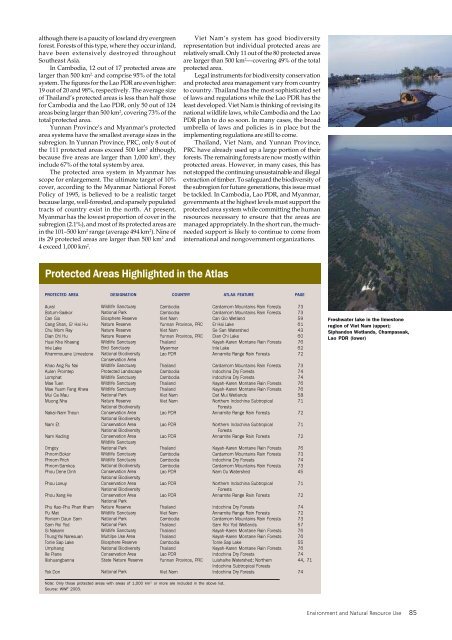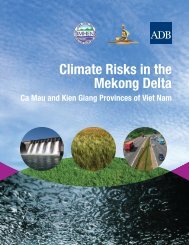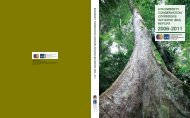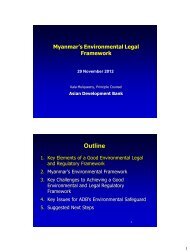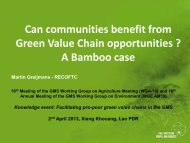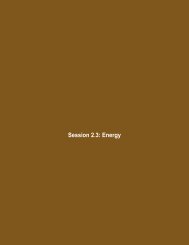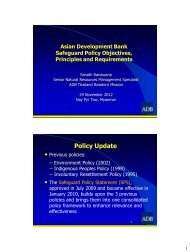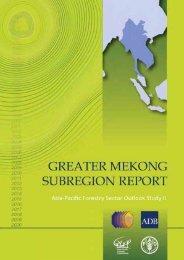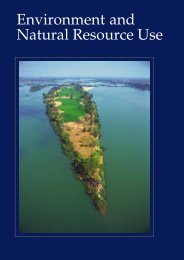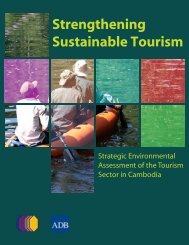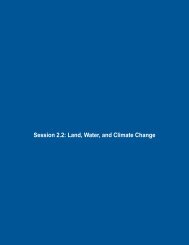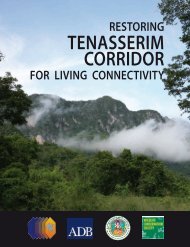Create successful ePaper yourself
Turn your PDF publications into a flip-book with our unique Google optimized e-Paper software.
although there is a paucity of lowland dry evergreenforest. Forests of this type, where they occur inland,have been extensively destroyed throughoutSoutheast Asia.In Cambodia, 12 out of 17 protected areas arelarger than 500 km 2, and comprise 95% of the totalsystem. The figures for the Lao PDR are even higher:19 out of 20 and 98%, respectively. The average sizeof Thailand’s protected areas is less than half thosefor Cambodia and the Lao PDR, only 50 out of 124areas being larger than 500 km 2 , covering 73% of thetotal protected area.Yunnan Province’s and Myanmar’s protectedarea systems have the smallest average sizes in thesubregion. In Yunnan Province, PRC, only 8 out ofthe 111 protected areas exceed 500 km 2 although,because five areas are larger than 1,000 km 2 , theyinclude 67% of the total system by area.The protected area system in Myanmar hasscope for enlargement. The ultimate target of 10%cover, according to the Myanmar National ForestPolicy of 1995, is believed to be a realistic targetbecause large, well-forested, and sparsely populatedtracts of country exist in the north. At present,Myanmar has the lowest proportion of cover in thesubregion (2.1%), and most of its protected areas arein the 101–500 km 2 range (average 494 km 2 ). Nine ofits 29 protected areas are larger than 500 km 2 and4 exceed 1,000 km 2 .Viet Nam’s system has good biodiversityrepresentation but individual protected areas arerelatively small. Only 11 out of the 80 protected areasare larger than 500 km 2 —covering 49% of the totalprotected area.Legal instruments for biodiversity conservationand protected area management vary from countryto country. Thailand has the most sophisticated setof laws and regulations while the Lao PDR has theleast developed. Viet Nam is thinking of revising itsnational wildlife laws, while Cambodia and the LaoPDR plan to do so soon. In many cases, the broadumbrella of laws and policies is in place but theimplementing regulations are still to come.Thailand, Viet Nam, and Yunnan Province,PRC have already used up a large portion of theirforests. The remaining forests are now mostly withinprotected areas. However, in many cases, this hasnot stopped the continuing unsustainable and illegalextraction of timber. To safeguard the biodiversity ofthe subregion for future generations, this issue mustbe tackled. In Cambodia, Lao PDR, and Myanmar,governments at the highest levels must support theprotected area system while committing the humanresources necessary to ensure that the areas aremanaged appropriately. In the short run, the muchneededsupport is likely to continue to come frominternational and nongovernment organizations.Protected Areas Highlighted in the AtlasPROTECTED AREA DESIGNATION COUNTRY ATLAS FEATURE PAGEAuralBotum-SaakorCan GioCang Shan, Er Hai HuChu Mom RayDian Chi HuHuai Kha KhaengInle LakeKhammouane LimestoneKhao Ang Ru NaiKulen PromtepLomphatMae TuenMae Yuam Fang KhwaMui Ca MauMuong NheNakai-Nam TheunNam EtNam KadingOmgoyPhnom BokorPhnom PrichPhnom SamkosPhou Dene DinhPhou LoeuyPhou Xang HePhu Kao-Phu Phan KhamPu MatRoniem Daun SamSam Roi YodSi NakarinThung Yai NaresuanTonle Sap LakeUmphangXe PianeXishuangbannaYok DonWildlife SanctuaryNational ParkBiosphere ReserveNature ReserveNature ReserveNature ReserveWildlife SanctuaryBird SanctuaryNational <strong>Biodiversity</strong>Conservation AreaWildlife SanctuaryProtected LandscapeWildlife SanctuaryWildlife SanctuaryWildlife SanctuaryNational ParkNature ReserveNational <strong>Biodiversity</strong>Conservation AreaNational <strong>Biodiversity</strong>Conservation AreaNational <strong>Biodiversity</strong>Conservation AreaWildlife SanctuaryNational ParkWildlife SanctuaryWildlife SanctuaryNational <strong>Biodiversity</strong>Conservation AreaNational <strong>Biodiversity</strong>Conservation AreaNational <strong>Biodiversity</strong>Conservation AreaNational ParkNature ReserveWildlife SanctuaryNational ParkNational ParkWildlife SanctuaryMultilpe Use AreaBiosphere ReserveNational <strong>Biodiversity</strong>Conservation AreaState Nature ReserveNational ParkCambodiaCambodiaViet NamYunnan Province, PRCViet NamYunnan Province, PRCThailandMyanmarLao PDRThailandCambodiaCambodiaThailandThailandViet NamViet NamLao PDRLao PDRLao PDRThailandCambodiaCambodiaCambodiaLao PDRLao PDRLao PDRThailandViet NamCambodiaThailandThailandThailandCambodiaThailandLao PDRYunnan Province, PRCViet NamCardamom Mountains Rain ForestsCardamom Mountains Rain ForestsCan Gio WetlandEr Hai LakeSe San WatershedDian Chi LakeKayah-Karen Montane Rain ForestsInle LakeAnnamite Range Rain ForestsCardamom Mountains Rain ForestsIndochina Dry ForestsIndochina Dry ForestsKayah-Karen Montane Rain ForestsKayah-Karen Montane Rain ForestsDat Mui WetlandsNorthern Indochina SubtropicalForestsAnnamite Range Rain ForestsNorthern Indochina SubtropicalForestsAnnamite Range Rain ForestsKayah-Karen Montane Rain ForestsCardamom Mountains Rain ForestsIndochina Dry ForestsCardamom Mountains Rain ForestsNam Ou WatershedNorthern Indochina SubtropicalForestsAnnamite Range Rain ForestsIndochina Dry ForestsAnnamite Range Rain ForestsCardamom Mountains Rain ForestsSam Roi Yod WetlandsKayah-Karen Montane Rain ForestsKayah-Karen Montane Rain ForestsTonle Sap LakeKayah-Karen Montane Rain ForestsIndochina Dry ForestsLuishaihe Watershed; NorthernIndochina Subtropical ForestsIndochina Dry Forests737359614360766272737474767658717271727673747345717274727357767655767444, 7174Freshwater lake in the limestoneregion of Viet Nam (upper);Siphandon Wetlands, Champassak,Lao PDR (lower)Note: Only those protected areas with areas of 1,000 km 2 or more are included in the above list.Source: WWF 2003.Environment and Natural Resource Use 85


